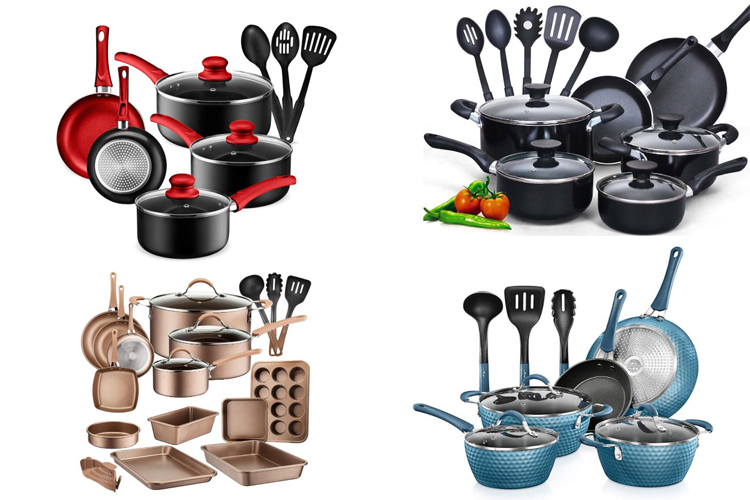- Español
- Português
- русский
- Français
- 日本語
- Deutsch
- tiếng Việt
- Italiano
- Nederlands
- ภาษาไทย
- Polski
- 한국어
- Svenska
- magyar
- Malay
- বাংলা ভাষার
- Dansk
- Suomi
- हिन्दी
- Pilipino
- Türkçe
- Gaeilge
- العربية
- Indonesia
- Norsk
- تمل
- český
- ελληνικά
- український
- Javanese
- فارسی
- தமிழ்
- తెలుగు
- नेपाली
- Burmese
- български
- ລາວ
- Latine
- Қазақша
- Euskal
- Azərbaycan
- Slovenský jazyk
- Македонски
- Lietuvos
- Eesti Keel
- Română
- Slovenski
- मराठी
- Srpski језик
Top-Rated Kitchen Cookware Set for Life&Home
2022-03-16
Complete Kitchen Cookware + Bakeware Set | Nonstick Ceramic Copper Coating – Frying Pans, Skillets, Stock Pots, Deep Square Fry Basket Cookie Sheet & Baking Pans

What's the Difference Between Cookware Set Materials?
Copper cookware heats the most evenly and is the most responsive (meaning, take your pan of hollandaise off the burner and it stops cooking immediately so there’s no danger it will curdle). But copper is super pricey and requires a lot of upkeep if you want to maintain its bright, shiny finish.
Next-best at heat distribution is aluminum. However, when you cook directly in aluminum some of the metal leaches into your food, giving it a gray-ish cast. The vast majority of aluminum cookware has some kind of finish, either enamel or nonstick, to prevent this from happening and also make it easier to clean. Some aluminum pans are hard-anodized, which means they’ve undergone an electrochemical process that strengthens and darkens the metal, protecting if from denting and stopping it from interacting with whatever you’re cooking. Aluminum cookware can’t be used on an induction burner unless it has a layer of stainless steel in the base.
Stainless steel is prized for its beautiful appearance and durability. However, it’s a poor conductor of heat. Any stainless cookware “worth its salt” will be either clad, meaning it has an interior core of aluminum that extends through the base and up the side, or will have a layer of aluminum in the bottom to give even heating. Cookware made of stainless steel is pricey and grease splatters can be difficult to clean off.
Nonstick cookware sets offer easy cooking and cleanup, especially for new cooks in the kitchen, but the coatings don't last forever and some have concerns about their safety. Read on for how to choose the right nonstick cookware set for you.

Are Nonstick Cookware Sets Safe?
-
There’s no argument with the fact that nonstick coatings keep food from sticking and make cleanup easier. However, these finishes don’t last forever; eventually they will lose their stick resistant properties. That might not bother you if you bought an inexpensive omelet pan but can be upsetting if you’ve invested in an expensive set.
-
-
Although there is no evidence that traditional nonstick coatings are toxic or harmful to cook in, they can release fumes if they overheat, which can happen if you preheat an empty nonstick pan or use it over very high heat. If you want the benefits of a nonstick coating but want to minimize any risks, you can opt for a ceramic nonstick coating. While these finishes, which are derived from sand, are not quite as good at releasing food and not as long-lasting, they can be safely used at higher heats.
Are Nonstick Cookware Sets Safe?
- There’s no argument with the fact that nonstick coatings keep food from sticking and make cleanup easier. However, these finishes don’t last forever; eventually they will lose their stick resistant properties. That might not bother you if you bought an inexpensive omelet pan but can be upsetting if you’ve invested in an expensive set.
-
- Although there is no evidence that traditional nonstick coatings are toxic or harmful to cook in, they can release fumes if they overheat, which can happen if you preheat an empty nonstick pan or use it over very high heat. If you want the benefits of a nonstick coating but want to minimize any risks, you can opt for a ceramic nonstick coating. While these finishes, which are derived from sand, are not quite as good at releasing food and not as long-lasting, they can be safely used at higher heats.





